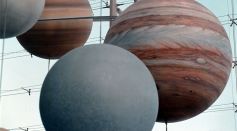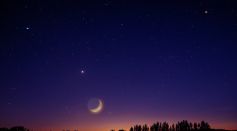Tags: Uranus

Voyager 2’s Historic Uranus Flyby May Have Captured Rare Event, Changing Scientists’ View of the Planet

Uranus' Weak Radiation Belts Possibly Linked to Tilted, Lopsided Magnetic Field Causing 'Traffic Jams'
Exotic Molecule Aquodiium That Doesn’t Form on Earth May Be Behind Neptune and Uranus’ Odd Magnetic Fields [Study]
James Webb Space Telescope to Investigate Auroras at Distant Planets Saturn, Uranus
3 Previously Unknown Moons Found Circling Neptune and Uranus: First Ever Lunar Discoveries Around These Planets
New Image of Neptune Shows It Has Similar Color to Planet Uranus
James Webb Space Telescope Captures Uranus’ Elusive Zeta Ring, Moons in Festive Photo

Infrared Auroras on Uranus Captured For the First Time: New Discovery Offers Clue to the Planet's Puzzling Heat

How to Spot Uranus and Neptune Amongst the Brightest Celestial Stars Tonight

Moon To Align With Uranus, Jupiter, and More: Here's What To Look Forward to in the Night Sky This Week
Does Uranus Have Rings? If It Does, Why Aren't They Visible?

Astronomy and Physics' Top 10 Most Peculiar Terminologies: Which Are the Quirkiest Ones?
Uranus-Size Planet Hiding at the Edge of Our Solar System Could Be Captured by the Sun
Planetary Alignment: 5 Planets Jupiter, Saturn, Mercury, Neptune, Uranus Will Make Rare Appearance in the Sky This Weekend

Giant Cyclone Spotted for the First Time in Uranus' North Pole, Confirming All Planets in the Solar System Can Have Polar Vortices

Uranus' Moons May Have Oceans Warm Enough To Support Life, Suggesting Should Look Into Them
Defining Science History: Four of the First Objects That Are Well-Regarded in the Scientific Community

Uranus' Glowing Rings, 27 Moons Captured in First Images Shared by NASA's James Webb Space Telescope

Planetary Parade: Five Planets, Crescent Moon Align in Night Sky

Two Uranus Moons Might Be Harboring Active Oceans That Release Materials to Space, Research Suggests
Most Popular

Trump Administration Declares COVID-19 Likely Originated from Wuhan Lab Leak, Citing Scientific Evidence

Largest Known Volcanic Aquifer Discovered Beneath Oregon's Cascades

New 'Supergiant' Sea Bug Found in South China Sea, Named After Darth Vader

Mediterranean Sea Was Refilled by a Catastrophic Flood Millions of Years Ago





